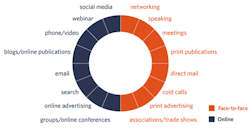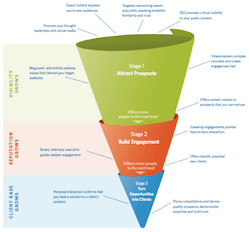How to generate architecture leads
Business development for architecture firms continues to get more sophisticated. While the Architecture Billings Index is more stable and even on a slight upward trend, closing new business can still be a struggle. Client referrals and networking are no longer the only way for architects to generate leads. So, when it comes to lead generation techniques for competing in today’s dynamic marketplace, three important lessons should be top of mind.
1. Embrace the new birthplace for leads. Lead generation is the process of identifying potential new clients. These are the marketing and business development activities that occur on the front-end and are typically lumped in with the process of developing relationships. For most principals and other C-suite executives, client referrals and professional networking have traditionally led their lead gen activities.
However for real growth, your lead generation techniques need to go further than tapping into existing clients. Truly effective lead generation today needs to encompass a full range of targeted online and offline measures. Think of it as a system that generates, qualifies, and nurtures leads until they become new business opportunities.
2. Acknowledge that all leads are not equal. But because some prospects are not ready to buy today, it doesn’t mean that they are not valuable for your overall growth strategy. In many firms, there is a tendency for those in business development roles to devalue and reject leads that are not ready to buy today. Nurturing long-term leads has an additional payoff, beyond the obvious. These long-term leads can also serve as an excellent referral sources.
3. Educational content actively drives referrals from non-clients. Traditionally, many firms have thought of referrals as only coming from clients or colleagues from other professions. These are major sources of referrals, but they’re not the only ones. In fact, our research shows that 81.5% of buyers have received a referral from someone they have never worked with.
Where do these non-client referrals come from?
Ninety-four percent of these referrals are made based on knowledge of a firm’s reputation, expertise, or visibility. Only 5.5% of these referrals come from someone that the referred firm has met before. So, focusing efforts on building your firm’s brand (reputation x visibility) and demonstrating your expertise are essential for moving beyond traditional client referrals and getting non-client referrals.
While traditional marketing techniques such as networking and sponsorships can help generate brand awareness, it can be extremely difficult to measure their effectiveness. Creating a quality content piece with a conversion action (e.g., Free Download: “A Guide to Cogeneration Plant Solutions”) nurtures prospects/referrals, builds trust and grows your email list.
These helpful content pieces can be free, but require an email address or other contact information to download. The idea here is that when someone searches on a specific keyword phrase, they will click through to this resource page. If the content on the page is relevant, the visitor will supply their email address and download the piece.
Educational content pieces should be thoughtfully created to be relevant to the issues that are most important to your target audiences. In marketing speak, we call this building the content funnel. Your firm should have a variety of content that will accomplish three goals: attract prospects, build engagement, and convert those prospects into clients.
Architecture lead generation will continue to evolve but today’s firm principals have a new arsenal to drive leads. Embrace the new online channels, think beyond your immediate return, and nurture prospects for the future.



